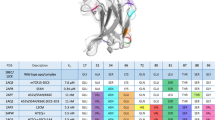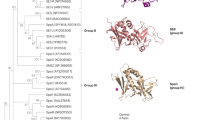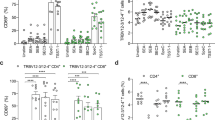Abstract
THE αβ T-cell antigen receptor (TCR) recognizes antigenic peptides in the context of self major histocompatibility complex (MHC) molecules1–4. The specificity of recognition of MHC plus antigen is generally determined by a combination of the variable elements of α- and β-chains of the TCR5–8. Several types of antigen, however, have been identified that, when bound to MHC molecules, stimulate T cells bearing particular variable-region β-chain (Vβ) elements irrespective of the other variable components of the TCR9–21. These have been termed 'superantigens', and here we are concerned with one type of superantigen, the toxins produced by Staphylococcus aureus. T cells have been found that bear closely related members of the same Vβ family but respond differently to S. aureus toxins15,19,22; in particular, cells bearing the human Vβl3.2 element respond to toxin SEC2, whereas cells bearing human Vβl3.1 do not. We have now defined the residues of the Vβ element responsible for this difference, and find that they reside in a region thought to lie on the side of the TCR molecule, away from the conventional antigen/MHC-binding site. The evolutionary conservation of this site may be due to its having an important role in some function of the TCR other than the binding of conventional antigen plus MHC.
This is a preview of subscription content, access via your institution
Access options
Subscribe to this journal
Receive 51 print issues and online access
$199.00 per year
only $3.90 per issue
Buy this article
- Purchase on Springer Link
- Instant access to full article PDF
Prices may be subject to local taxes which are calculated during checkout
Similar content being viewed by others
References
Babbitt, B., Allen, P., Matsueda, G., Haber, E. & Unanue, E. Nature 317, 359–361 (1985).
Buus, S., Sette, A., Colon, S., Miles, C. & Grey, H. Science 235, 1353–1358 (1987).
Townsend, A., Rothbard, J., Gotch, F., Bahadur, G., Wraith, D. & McMicheal, A. Cell 44, 959–968 (1986).
Bjorkman, P. J., Saper, M. A., Samraoui, B., Bennett, W. S., Strominger, J. L. & Wiley, D. C. Nature 329, 506–512 (1987).
Marrack, P. & Kappler, J. W. Immun. Today 9, 308–315 (1988).
Toyonaga, B. & Mak, T. W. A. Rev. Immun. 5, 585–620 (1987).
Davis, M. A. Rev. Immun. 4, 529–591 (1985).
Hedrick, S. et al. Cell 30, 141–152 (1982).
Kappler, J., Roehm, N. & Marrack, P. Cell 49, 273–280 (1987).
Kappler, J. et al. Cell 49, 263–271 (1987).
MacDonald, H. R. et al. Nature 332, 40–45 (1988).
Pullen, A. M., Marrack, P. & Kappler, J. W. Nature 335, 796–801 (1988).
Kappler, J. W., Staerz, U., White, J. & Marrack, P. C. Nature 332, 35–40 (1988).
Abe, R. & Hodes, J. R. J. Immun. 140, 4132–4138 (1988).
White, J. et al. Cell 56, 27–35 (1989).
Janeway, C. A. Jr et al. Immunol. Rev. 107, 61–88 (1989).
Bekoff, M. C., Cole, B. C., & Grey, H. M. J. Immun. 139, 3189–3194 (1988).
Kappler, J. et al. Science 244, 811–813 (1989).
Choi, Y. et al. Proc. natn. Acad. Sci. U.S.A. 86, 8941–8945 (1989).
Pullen, A. M., Wade, T., Marrack, P., & Kappler, J. Cell (in the press).
Fleischer, B., & Schrezenmeir, H. J. exp. Med. 167, 1697–1707 (1988).
Callahan, J. E., Herman, A., Kappler, J., & Marrack, P., J. Immun. 144, 2473–2479 (1990).
Herman, A., Croteau, G., Sekaly, R., Kappler, J., & Marrack, P. J. exp. Med. (in the press).
Chothia, C., Boswell, D. R. & Lesk, A. M. EMBO J. 7, 3745–3755 (1988).
Kubo, R. T., Born, W., Kappler, J., Marrack, P. & Pigeon, M. J. Immun. 142, 2736–2742 (1989).
Leo, O., Foo, M., Sachs, D., Samelson, L. & Bluestone, J. Proc. natn. Acad. Sci. U.S.A. 84, 1374–1378 (1987).
Saiki, R. K. et al. Science 239, 487–491 (1988).
Blackman, M. et al. Cell 47, 349–357 (1986).
Burgert H. G., White, J., Weltzein, H. U., Marrack, P., & Kappler, J. J. exp. Med. 170, 1887–1904 (1989).
Kumura, N., Toyonaga, B., Yoshikai, Y. & Mak, T. W. Eur. J. Immun. 17, 375–383 (1987).
Duby, A. D. & Seidman, J. G. Proc. natn. Acad. Sci. U.S.A. 83, 4890–4894 (1986).
Ho, S. N., Hunt, H. D., Horton, R. M., Pullen, J. K. & Pease, L. R. Gene 77, 51–59 (1989).
Author information
Authors and Affiliations
Rights and permissions
About this article
Cite this article
Choi, Y., Herman, A., DiGiusto, D. et al. Residues of the variable region of the T-cell-receptor β-chain that interact with S. aureus toxin superantigens. Nature 346, 471–473 (1990). https://doi.org/10.1038/346471a0
Received:
Accepted:
Issue Date:
DOI: https://doi.org/10.1038/346471a0
This article is cited by
-
Update on molecular diversity and multipathogenicity of staphylococcal superantigen toxins
Animal Diseases (2021)
-
T cell-directed IL-17 production by lung granular γδ T cells is coordinated by a novel IL-2 and IL-1β circuit
Mucosal Immunology (2018)
-
Superantigen antagonist protects against lethal shock and defines a new domain for T-cell activation
Nature Medicine (2000)
-
Crystal structure of the streptococcal superantigen SPE-C: dimerization and zinc binding suggest a novel mode of interaction with MHC class II molecules
Nature Structural Biology (1997)
-
Role of the T cell receptor α-chain in superantigen recognition
Immunologic Research (1996)
Comments
By submitting a comment you agree to abide by our Terms and Community Guidelines. If you find something abusive or that does not comply with our terms or guidelines please flag it as inappropriate.



